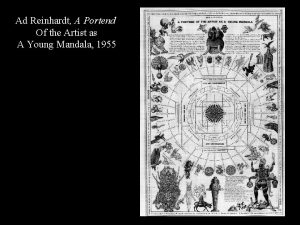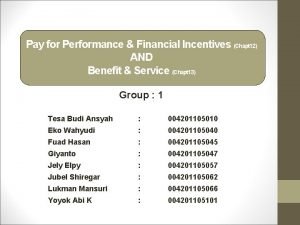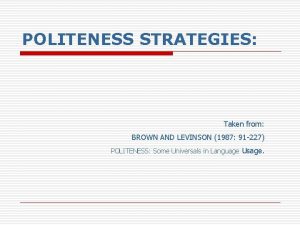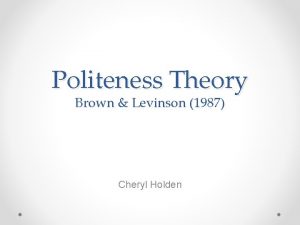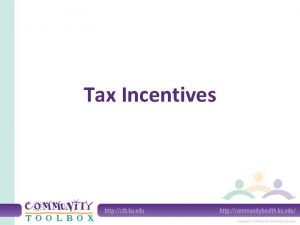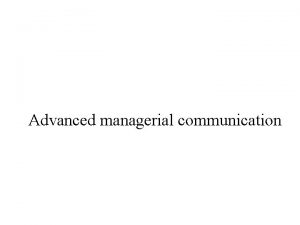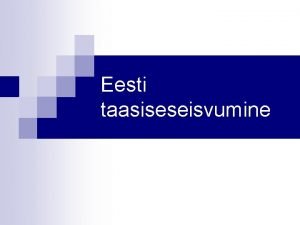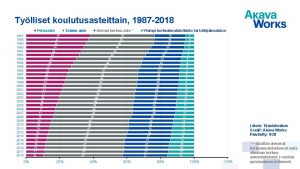Lecture 8 Managerial Incentives Fershtman and Judd 1987









- Slides: 9

Lecture 8: Managerial Incentives (Fershtman and Judd (1987), American Economic Review -begins on page 927. ) Article examines how firm incentives are affected by the separation between owners and managers. Strategic effect of competition in oligopoly plays a key role Setting: Two Stage Game I. In the first stage, owners (stockholders) determine the type of incentive contracts that they offer managers II. In the second stage, managers choose how much to produce. (Firms compete in Cournot competition)

The Model: Contracts offered to managers are of form: Oi = i i + (1 - i)si where i = profits, Si = sales, and i is the weight placed on each of the components. Note that nothing says that the weights have to be between 0 and 1. Why do restrict ourselves to such contracts? Because they seem to be common in the “real world” Actually, the contracts of the form: Ai+Bi. Oi , and competition in the market for managers means that max{Ai+Bi. Oi}=w, the going wage for managers

Other Assumptions: • Demand function: P=a-b. Q • “b” is known to managers, but unknown to owners (This means that there is asymmetric information; models with asymmetric information are very common in the managerial compensation literature. ) • Marginal cost is constant and equal to “c” for both firms. • There is Cournot competition in the product market.

Model is solved by backwards induction. In the second stage, managers choose how much to produce, that is, they choose q 1 and q 2 to maximize their compensation O 1 = 1 1+(1 - 1)S 1 = 1 (a-b. Q-c)q 1 +(1 - 1)(a-b. Q)q 1, Where Q=q 1+q 2. If we differentiate the above equation, we get the following best response function: q 1 = (a-bq 2)/2 b - 1 c/2 b. When 1<1, the manager moves away from strict profit maximization. Note that as 1 decreases, q 1 increases. Hence manager “ 1” becomes more aggressive (he produces more) when more of his salary depends on sales, rather than profits.

Solving the “best response” functions yield: q 1*=(a-2 1 c+ 2 c)/3 b q 2*=(a-2 2 c+ 1 c)/3 b P*=(a+ 1 c+ 2 c)/3 As 1 and 2 fall, P falls, because managers place more emphasis on sales.

First Stage In the first stage, owners (stockholders) determine the type of incentive contracts that they offer managers, that is they choose 1 and 2. Each owner chooses 1 maximizes: 1 = (P*-c)q 1* -w 2 = (P*-c)q 2* -w (where P*, q 1*, q 2* are functions of 1 and 2) FOC yield the following best response functions: 1 =3/2 – a/4 c - 2/4 Notice that substituting 2=1 into the above equation yields 1<1 (since a>c).

Solving the best response functions yield: 1*= 2*= 1 – (a-c)/5 c <1. (Notice that 1*& 2* do not depend on “b”. q*=2(a-c)/5 P*=(a+4 c)/5 [Pcournot =(a+2 c)/3 > P*] 1*= 2(a-c)2/25 b [ 1 cournot =(a-c)2/9 b > 1*]

A: Nash equilibrium without owner/manager q 2 B: Nash equilibrium with owner/manager C: “commitment” – manager of firm 1 more aggressive B A C q 1

The separation of owners and managers leads to a prisoner’s dilemma structure. Each owner has a unilateral incentive to set less than one (that is, provide contract partially based on sales). This is a “top dog” strategy. In equilibrium, both owners have such incentives, and owners earn less in equilibrium that they would in the setting without separation between owners and managers. But owners cannot tell their managers just to produce the “Cournot” amount because “b” is unknown to owners



